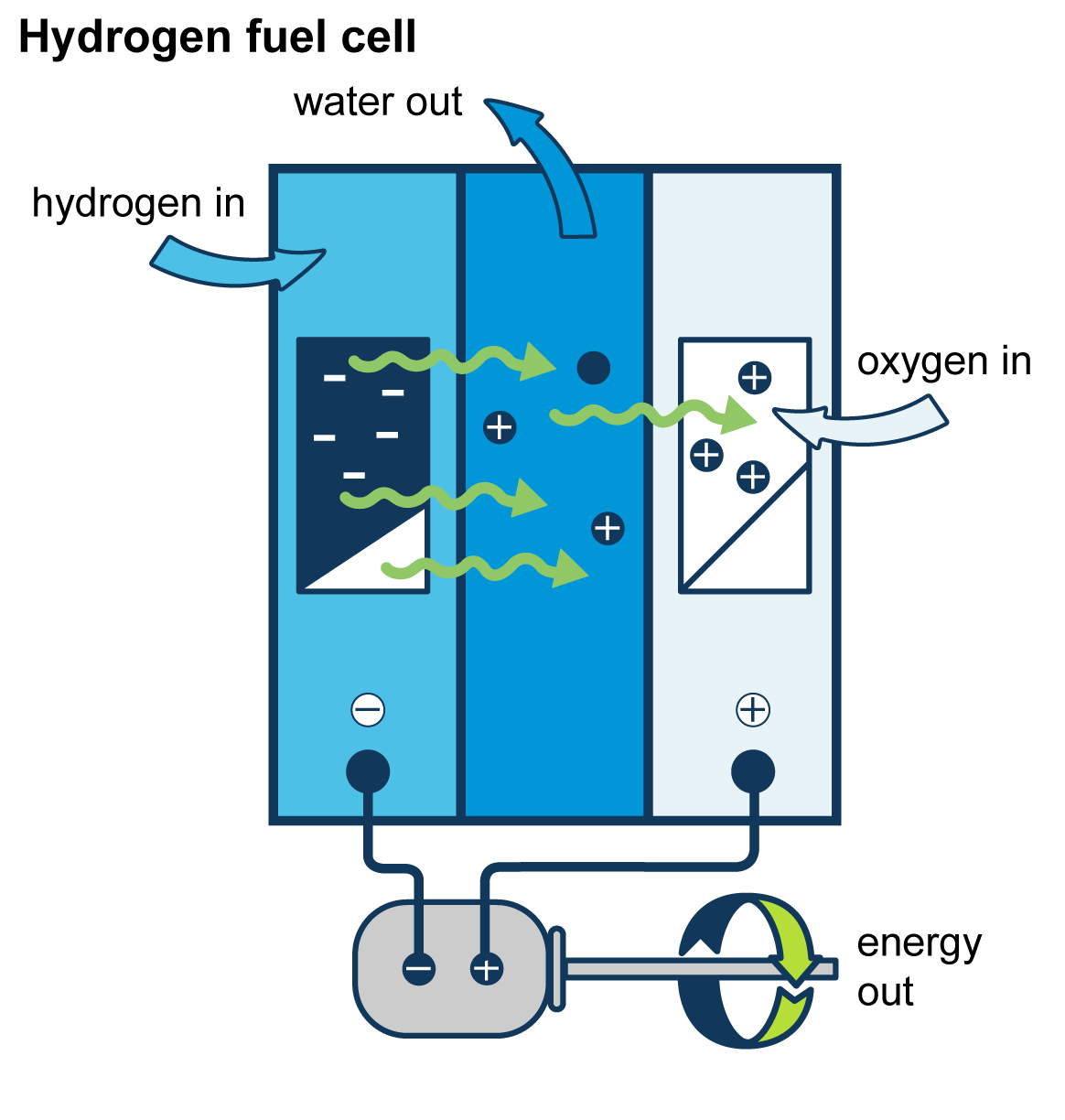Hydrogen has many actual and potential uses
Hydrogen is used in industrial processes, as a rocket fuel, and in fuel cells for electricity generation and powering vehicles. Operators of several natural gas-fired power plants are exploring hydrogen as a supplement or replacement for natural gas. Hydrogen has the potential to indirectly store energy for electric power generation.
Hydrogen is used in industrial processes
Nearly all hydrogen consumed in the United States is used by industry for refining petroleum, treating metals, producing fertilizer and other chemicals, and processing foods. U.S. petroleum refineries use hydrogen to lower the sulfur content of fuels. Biofuel producers also use hydrogen to produce hydrotreated vegetable oil (HVO) for use as renewable diesel.
Hydrogen fuel cells produce electricity
Hydrogen fuel cells produce electricity by combining hydrogen and oxygen atoms. The hydrogen reacts with oxygen across an electrochemical cell—similar to a battery—to produce electricity, water, and small amounts of heat.
Fuel cells vary in size, type, and application. Fuel cell power plants provide electricity for individual facilities and have potential applications in microgrids and for remote locations that are not connected to electric power grids. Several vehicle manufacturers have developed fuel cells for powering vehicles.
Fuel cell power plants
Fuel cell power plants generate electricity (and heat in a few cases), mostly as supplemental or backup power supply for individual buildings or facilities. As of the end of March 2024, the United States had about 210 operating fuel cell electric power generators at 151 facilities with about 384 megawatts (MW) of total nameplate electric generation capacity.1 The nameplate capacities range from the largest single-fuel cell, with about 17 MW nameplate capacity at the Bridgeport Fuel Cell, LLC facility in Connecticut, to 10 fuel cells, with 0.1 MW capacity each, at the California Institute of Technology. Most operating fuel cells use pipeline natural gas as the hydrogen source, but five fuel cell power plants use biogas from wastewater treatment and one uses landfill gas. In 2022, fuel cells provided less than 1% of total annual U.S. electricity generation.
Fuel cells for vehicles
Hydrogen is classified as an alternative vehicle fuel under the Energy Policy Act of 1992. The interest in hydrogen as an alternative transportation fuel stems primarily from its potential to power fuel cells in zero-emission vehicles (vehicles with no emissions of air pollutants). A fuel cell may be two to three times more efficient than an internal combustion engine running on gasoline. Several vehicle manufacturers have hydrogen fuel cell-vehicles. A few test vehicles are available to organizations with access to hydrogen-fueling stations.
The high cost of fuel cells and the limited availability of hydrogen fueling stations have limited the number of hydrogen-fueled vehicles in use today. Production of hydrogen-fueled vehicles is limited because people won't buy those vehicles if hydrogen refueling stations are not easily accessible, and companies won't build refueling stations if they don't have customers with hydrogen-fueled vehicles. The United States has about 60 hydrogen-vehicle-fueling stations, all of which are in California. The State of California's Advanced Clean Cars Program includes assistance for establishing publicly accessible hydrogen vehicle fueling-stations throughout California to promote a consumer market for zero-emission fuel cell vehicles.
Hydrogen can be burned for electricity generation and heating
Burning hydrogen for electric power generation and for heating are potential uses of pure hydrogen or hydrogen-rich blends with natural gas. However, using hydrogen and hydrogen-blends in existing natural gas distribution infrastructure and combustion equipment poses a number of challenges related to materials compatibility and combustion characteristics. Some progress has been made with modifying natural gas burners in commercially available combustion turbines to accommodate high-hydrogen blends (up to 100% hydrogen), but continued research, development, and demonstration (RD&D) is needed before hydrogen will qualify for utility-scale power generation. Several power plants in the United States have announced plans to operate on a natural gas-hydrogen fuel mixture in combustion-gas turbines. One example is the Long Ridge Energy Generation Project in Ohio. RD&D is also needed to assess the compatibility of using hydrogen and hydrogen–natural gas blends in heating appliances.
Hydrogen can be used for energy storage
Hydrogen storage is an important technology for enabling hydrogen use across the U.S. economy. Hydrogen may be stored as a:
- Gas—Hydrogen can be stored as a gas in large volumes in natural geological formations—salt caverns, lined hard rock caverns, depleted oil and natural gas fields, and aquifers. Gaseous hydrogen may also be stored in relatively smaller volumes in pressurized stationary or portable tanks and in dedicated hydrogen gas pipeline infrastructure. Gaseous storage is the most common and the most likely option for expanding hydrogen storage for most hydrogen use as an energy source.
- Liquid—Hydrogen can be liquefied by cooling it to below -423oF (−253oC). Liquefied hydrogen can be stored in super-cooled (cryogenic) tanks for transportation applications in fuel cell vehicles or directly as fuel in truck, rail, marine, and rocket engines—NASA has the two largest liquid hydrogen storage tanks in the world. Hydrogen liquefaction and cyrogenic liquid storage is an energy-intensive and expensive process.
Hydrogen could facilitate decarbonization of the electric power sector by storing energy produced with renewable energy for days or even weeks. Hydrogen could be produced with renewable resources when renewable energy production is high and could be stored to generate electricity when renewable resources are limited and electricity demand is high. One example is the Advanced Clean Energy Storage project in Utah, which plans to store large volumes of gaseous hydrogen produced from renewable resources for long-term seasonal energy storage.
1 Source: U.S. Energy Information Administration, Preliminary Monthly Electric Generator Inventory, April 24, 2024.
Last updated: June 21, 2024.


